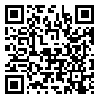Volume 15, Issue 1 (3-2022)
IJMEHM 2022, 15(1): 122-136 |
Back to browse issues page
Download citation:
BibTeX | RIS | EndNote | Medlars | ProCite | Reference Manager | RefWorks
Send citation to:



BibTeX | RIS | EndNote | Medlars | ProCite | Reference Manager | RefWorks
Send citation to:
Fekripour K, Heidarpour A. Psychotherapy in Ancient Iran and Mesopotamia (Based on Ancient Iranian Texts and Mesopotamian Tablets). IJMEHM 2022; 15 (1) :122-136
URL: http://ijme.tums.ac.ir/article-1-6455-en.html
URL: http://ijme.tums.ac.ir/article-1-6455-en.html
1- Associate Professor, department of ancient languages and texts Faculty of Iranian Linguistics, Inscriptions and Texts, Institute of Iranian Cultural Heritage and Tourism
2- Assistant Professor, department of ancient languages and texts, Faculty of Iranian Linguistics, Inscriptions and Texts, Institute of Iranian Cultural Heritage and Tourism
2- Assistant Professor, department of ancient languages and texts, Faculty of Iranian Linguistics, Inscriptions and Texts, Institute of Iranian Cultural Heritage and Tourism
Abstract: (1138 Views)
Stress and psychological problems arose with the advent of urbanization. Ancestors generally knew disease as the result of interaction with external factors, including gods, demons, and spirits. The Iranians considered the disease created by the devil and the Mesopotamians considered the disease as a result of wrath of the gods on the sick person for various reasons. This study tries to show the knowledge of Iranians and Mesopotamians about mental illnesses and tries to answer these questions: What information about the treatment of mental illnesses has reached us through the ancient texts of the ancient Iranians and the tablets of the Mesopotamians? And was there also a difference between a physician and a psychiatrist? What similarities and differences can be seen in ancient Iranian texts and Mesopotamian tablets about these contents? In Iranian texts, we are a little familiar with the topic of psychiatry, but the Mesopotamian tablets, which are older, provide us with more details about mental illness. What is certain is that they did not know enough about mental illnesses because they were unfamiliar with brain function; As a result, they resorted to magic and sorcery to cure it. Psychotherapists had a high position in the Iranian and Mesopotamian society and were considered a clergyman. They worked with the physician to treat many ailments. This is a historical- descriptive research, and the subject matter has been gathered in a library way.
Type of Study: Research |
Subject:
History of Medicine
Received: 2021/12/28 | Accepted: 2022/04/27 | Published: 2022/03/21
Received: 2021/12/28 | Accepted: 2022/04/27 | Published: 2022/03/21
| Rights and permissions | |
 |
This work is licensed under a Creative Commons Attribution-NonCommercial 4.0 International License. |






